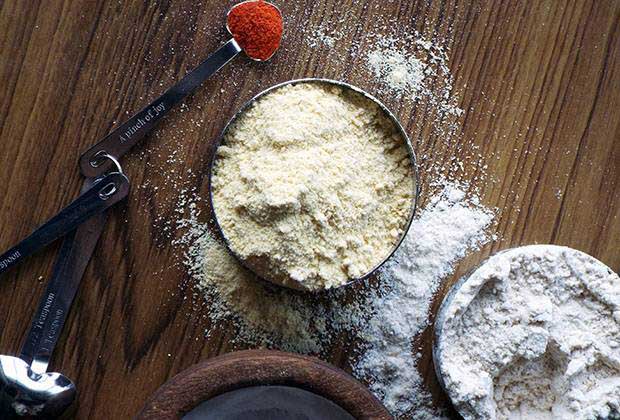5 Healthy Substitutes For Everyday Flour
- By Danya DhanakLoading...
- | 5 May 2016 3:35 PM IST
 X
X
 Makki roti in process. Photo: Danya Dhanak
Makki roti in process. Photo: Danya Dhanak
As Indians, we consume too much wheat on a daily basis. A piece of toast in the morning, two rotis at lunch, a sandwich for a snack, two biscuits at tea-time and it goes on. Make a lifestyle change and swap out your regular atta roti for one that incorporates these five whole grains and pulses. Each one has a different flavour and nutritional profile, but I can assure you that they’re as satisfying as wheat (if not more).
These inherently gluten-free grains or pulses may need some wheat to help bind the dough (gluten is the protein present in wheat that helps create elasticity and binds it together). If you are following a gluten-free diet, you can consider adding xanthan gum, potato starch, rice flour, corn starch and other binding agents to help you make uniform rotis with these grains and pulses. You may find it challenging at first to knead the flours together – if so, start with a 1:1 ratio of the new grain you are using along with whole wheat atta and work your way up to using less and less wheat.
It can be difficult to replace your normal roti with something new like a dal or ragi roti – some family members and children might resist this change as they seek comfort in what they already know. To help you out, I’ve included a few innovative serving ideas to help incorporate these alternatives into your diet.
Ragi, also commonly known as nachni or finger millet
Popular in the south, this type of millet is commonly used for idli, dosa and a traditional kind of south Indian laddu. It has only recently gained popularity outside of its traditional uses – you may have come across nachni chips at your local snack store or a new collection of ragi-based breakfast cereal at grocery stores. My family discovered it a few years ago after being recommended to eat it for its high iron, calcium and protein content. Ever since, we have been using the flour to make rotis.
Best way to eat it: Paratha stuffed with a mix of paneer, chopped onions, chili pepper and chaat masala.
ALSO WATCH: How To Make Ragi Dosa
Jowar, also commonly known as sorghum
Jowar is another kind of millet that has historically been a staple in India. While it is still produced and popular in Western rural India, it is almost forgotten in today’s urban India. Rich in antioxidants, fibre, minerals and with a low glycemic index, jowar takes longer to digest thus keeping you full for long time. Gujaratis typically use this and bajra (more below) to make rotlas, a thicker flatbread cooked on a clay griddle. Simply bind the flour together with water and a pinch of salt. In Maharashtra and Rajasthan, a more typical roti is made. The same mix of jowar flour, water and salt (and wheat atta if needed) can yield thinner fluffy rotis if you can knead and roll out rotis well.
Best way to eat it: Make rotlas by simply binding the flour together with water and a pinch of salt.
 Ragi paratha stuffed with paneer. Photo: Danya Dhanak
Ragi paratha stuffed with paneer. Photo: Danya Dhanak
Bajra, also commonly known as pearl millet
Bajra or pearl millet is probably the most well-known and commonly used kind of millet. Also native to Rajasthan, bajra is an excellent source of gluten-free protein, fibre, vitamin B6, phosphorus and other minerals. One of my favourite memories of bajra is eating it in the Gujarati rotla form with fresh green garlic mixed into the dough. To both bajra and jowar flour, you can add any other herbs and spices such as fresh cilantro or coriander leaves, oregano, thyme, green chili and whole jeera to the dough for zest. Make it the same way as a jowar roti or rotla.
Best way to eat it: Add fresh coriander leaves, herbs and spices like whole jeera to the dough.
Makki, also commonly known as cornmeal or maize flour
During winter, I visited friends at their Delhi farmhouse where we ate farm-fresh makki roti with seasonal vegetables and paneer. I likened the flavour to tortillas and my friend laughed but really, makki roti doesn’t have to be something you only eat at weddings in the winter with sarson ka saag. It is high in fibre, antioxidants, thiamin (vitamin B1) and phosphorus, making it a good alternative. Mix one part makki flour, one part wheat atta, a pinch of salt and red chilli powder to make thin rotis.
Best way to eat it: A Mexican-inspired wrap filled with cooked rajma, spiced tofu or paneer, sautéed onions and a tomato salsa.
RECIPE: Home-made Sarson ka Saag
Split green gram or moong dal
This is perhaps the most protein-rich alternative to wheat of all the ones mentioned above. It is a more acquired taste than the rest, but its nutritional benefits are superior. This type of pulses is low fat and high in vitamin B, potassium and calcium and relatively easy to digest. You can buy the flour ready, grind it at home or send the dal to your local flour grinder. For this wheat roti alternative, at least a 70:30 ratio of dal flour to wheat flour along with water is necessary to bind the dough. Eat it with your everyday vegetables in place of a roti or try it as a wrap filled with spiced potatoes, yogurt, sweet tamarind and date chutney or green chutney.
The author recently moved back to India after studying at the University of Michigan following a job at an investment bank in New York. She shares recipes and travel tips on her blog The India Edition.



